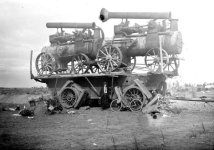I thought I would add this beast to the discussion.
Big Lizzie
Big Lizzie played an important part in the clearing of Red Cliffs and this is a brief outline of it's history. In early 1915 Frank Bottrill commenced construction of Big Lizzie to replace the camel trains which carried wool and other heavy loads in the sandy terrain. Fabrication and assembly of the huge prime mover and two trailers was carried out by Bottrill over a period of 12 months
Early in 1916 Big Lizzie left Richmond expecting to be in Broken Hill by early 1917. The route chosen was via Kilmore, Heathcote, Elmore and Echuca, where it was proposed to cross the Murray River. The first major problem occurred when the prime mover broke through a bridge near Kilmore causing a dent in the drinking water tank which is still evident to this day. When Lizzy reached the flooded Campaspie River a suitable crossing site was located below the weir near Elmore. It took 3 weeks of de-snagging and earthworks to cross the river.
Bottrill was unable to cross the Murray at Echuca because of floods, and the lack of permission to cross the approach bridge to the town, so he headed for Swan Hill. He arrived at Kerang in January 1917 and spent 5 months there carrying out modifications, it was August 1917 before he reached Ouyen. In October 1917 Big Lizzie reached Mildura to find the Murray River in flood, so without a bridge to cross the river completing his journey was out of the question for several months at least. As Bottrill had not yet earned one penny in income he sought work in the area.
In 1920 Big Lizzie commenced clearing scrub for the proposed 6,000 ha irrigation area of Red Cliffs. This was to provide 700 Soldier Settlement blocks for veterans of World War 1. A gang of up to 16 men was employed to handle the four heavy cables which were attached with loops and hooks to as large a number of trees or stumps as possible. Repairs to damaged cables etc was carried out on the front platform of Big Lizzie, which was equipped with blacksmith's forge, anvil and toolbox.
Clearing work at Red Cliffs was completed in 1924 and Big Lizzie was driven to Western Victoria to find more work clearing land. In 1938 the Blackstone engine was sold and moved to Pyramid Hill where it was used to drive stone crushing equipment until 1942. It was finally broken up for scrap in 1945. In 1971 (the year of Red Cliffs Golden Jubilee) a committee was formed to negotiate the purchase and return of Big Lizzie to Red Cliffs. Big Lizzie and one trailer now hold pride of place in Barclay Square Red Cliffs. The second trailer awaits restoration. The shelter over Big Lizzie was erected in 1988 by Mildura Shire Council as a Bicentennial project.
Specifications
Length: 34 feet, Height: 18 feet, Weight: 45 tons
Turning radius - 200 feet, Complete train - 98 feet long
Powered by 60hp Blackstone crude oil engine
Four Forward Gears - 1/2 - 2 mph, Two reverse gears - 1/4 - 1/2 mph
Carrying capacity: 80 tons.
Lots of information on it can be found by googling Big Lizzie
Cheers
Rohan



